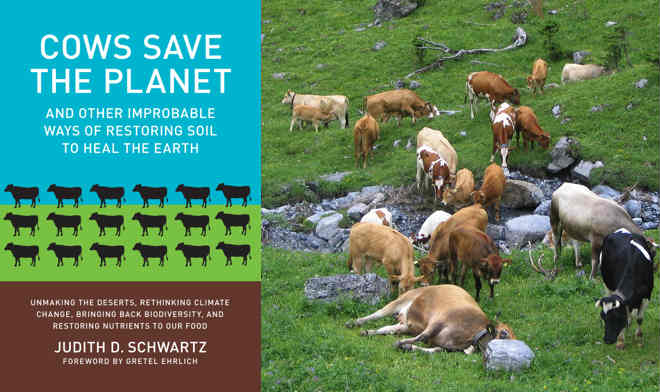Judith Schwartz’s Cows Save the Planet: And Other Improbable Ways of Restoring Soil to Heal the Earth, is, in her own words, “a call to action on behalf of the soil.” In her book, she uses soil as a springboard for an examination of the ways that human behaviors are condemning the environment to near-irreversible devastation. She asks the reader to consider the soil from a worm’s-eye view, crafting an open address on behalf of an entity that can do everything for itself except speak up.
Schwartz highlights the importance of giving soil a chance to self-regenerate through its natural capacity for healing. Schwartz argues that the time when many basic reclamation projects – such as China’s current multi-billion dollar “Great Green Wall” reforestation project, in which the Chinese government is planting a belt of millions of trees to attempt to stem the growth of the Gobi desert – that could have proven useful is long past. In many places on the planet, existing soil does not have the natural or environmental support that it needs to restore itself. Not one to mince words (she highlights how the term “dirt” neutralizes the rich meaning of “soil” in the cultural vernacular), Schwartz advocates aggressive methods of reversing the behaviors behind climate change.
Schwartz is concerned that many so-called half measures – even some with demonstrable support in the food movement – are insufficient to meet extensive ecological needs. When it comes to the release of harmful greenhouse gases, even the virtually impossible cessation of 100 percent of all carbon emissions wouldn’t make a significant dent in reducing carbon dioxide levels for some time. Simply cutting emissions would do little in the short term to help a damaged planet hemorrhaging 83 billion tons of topsoil every year. Restoring carbon to soil at at a rate that matters, she argues, entails innovative reverse engineering. Enacting this process through an admittedly unlikely candidate – the cow – could yield many lasting benefits for the process of restoring biodiversity.
Favoring an approach that succinctly outlines many of the problems contributing to current soil degradation – desertification, livestock mismanagement, the disappearance of nutrients from diets – and underscoring the many points at which they intersect, Schwartz comments on the way that humanity’s relationship with the earth is growing increasingly one-sided. Smartly anecdotal and unfailingly committed to change, Schwartz’s book isn’t quite an “open in case of emergency” sign for the food movement – but it’s close.















